Last Updated on January 28, 2021 by Admin
Cert Practice Exam ICND2 2016 Answer
-
What are two load-balancing methods in the EtherChannel technology? (Choose two.)
- combination of source port and IP to destination port and IP
- source IP to destination IP
- source port to destination port
- combination of source MAC and IP to destination MAC and IP
- source MAC to destination MAC
-
Which is a characteristic of EtherChannel?
- EtherChannel uses physical ports that have been upgraded to provide a faster connection.
- STP will not block redundant EtherChannel bundles between two switches.
- STP treats all interfaces in a bundle as a single logical link.
- EtherChannel configuration is applied to each physical port.
-
Refer to the exhibit. A network administrator is reviewing the configuration of switch S1. Which protocol has been implemented to group multiple physical ports into one logical link?

Cert Practice Exam ICND2 007
- PAgP
- DTP
- LACP
- STP
-
Which three STP states were replaced with the RSTP discarding state? (Choose three.)
- listening
- learning
- blocking
- disabled
- forwarding
-
What two STP features are incorporated into Rapid PVST+? (Choose two.)
- UplinkFast
- PortFast
- BPDU guard
- BPDU filter
- BackboneFast
- loop guard
-
Refer to the exhibit. All the displayed switches are Cisco 2960 switches with the same default priority and operating at the same bandwidth. Which three ports will be STP designated ports? (Choose three.)

Cert Practice Exam ICND2 005
- fa0/9
- fa0/10
- fa0/11
- fa0/13
- fa0/20
- fa0/21
-
What is the value used to determine which port on a non-root bridge will become a root port in a STP network?
- the highest MAC address of all the ports in the switch
- the lowest MAC address of all the ports in the switch
- the VTP revision number
- the path cost
-
If no bridge priority is configured in PVST, which criteria is considered when electing the root bridge?
- lowest IP address
- lowest MAC address
- highest IP address
- highest MAC address
-
Refer to the exhibit. Users on the R1 LAN and R2 LAN are unable to communicate. Based on the IPv6 addressing of the network displayed, what is the problem?
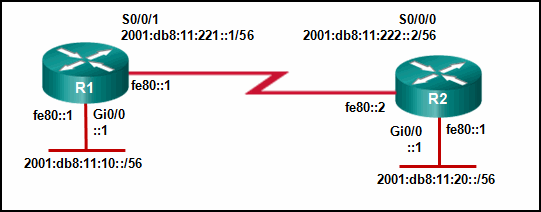
Cert Practice Exam ICND2 004
- R1 has a link-local address conflict with interfaces Gi0/0 and S0/0/1.
- The serial interfaces on R1 and R2 are on different subnets.
- A link-local and global unicast address cannot both be configured on an interface.
- The LAN interfaces on R1 and R2 are on the same subnet.
-
Which statement describes the Cisco License Manager?
- It is a free, standalone software application for deploying Cisco software licenses across the network.
- It is a web-based portal for getting and registering individual software licenses.
- It is a centralized TFTP server that enables control of the number and revision level of Cisco IOS images.
- It is an organized collection of processes and components used to activate Cisco IOS software feature sets by obtaining and validating Cisco software licenses.
-
After a license has been purchased and installed, what is the next step that is required before it is activated?
- Reboot the router.
- Copy the running configuration to NVRAM.
- Copy the running configuration to flash.
- Issue the license boot module technology-package command.
-
An administrator wants to replace the configuration file on a Cisco router by loading a new configuration file from a TFTP server. What two things does the administrator need to know before performing this task? (Choose two.)
- router IP address
- TFTP server IP address
- name of the configuration file that is currently stored on the router
- name of the configuration file that is stored on the TFTP server
- configuration register value
-
Refer to the exhibit. A network engineer is preparing to upgrade the IOS system image on a Cisco 2901 router. Based on the output shown, how much space is available for the new image?

Cert Practice Exam ICND2 013
- 25574400 bytes
- 249856000 bytes
- 221896413 bytes
- 33591768 byte
-
Refer to the exhibit. Based on this configuration, which two OSPF router roles are assumed by R2? (Choose two.)

Cert Practice Exam ICND2 011
- backbone router
- internal router
- designated router
- area border router
- autonomous system boundary router
-
What are the only two roles that permit an OSPF router to be configured for summarization? (Choose two.)
- backbone router
- internal router
- designated router
- area border router
- autonomous system boundary router
-
Which two addresses represent valid destination addresses for an OSPFv3 message? (Choose two.)
- FF02::5
- 224.0.0.5
- FF02::A
- FE80::42
- 2001:db8:acad:1::1
-
An OSPFv3 router has no IPv4 addresses configured and the router ID has not been manually set. What is the result of this configuration?
- OSPFv3 will not start.
- The highest IPv6 address of a loopback interface will be used as the router ID.
- The highest IPv6 address of a physical interface will be used as the router ID.
- The router will automatically generate a router ID using the MAC address of one of the interfaces.
-
Refer to the exhibit. Which address will R1 use as the source address for all OSPFv3 messages that will be sent to neighbors?

Cert Practice Exam ICND2 012
- FE80::1
- 2001:DB8:ACAD:A::1
- FF02::1
- FF02::5
-
When OSPFv2 neighbors are establishing adjacencies, in which state do they elect a DR and BDR router?
- Exchange state
- Init state
- Two-Way state
- Loading state
-
A network administrator has just changed the router ID on a router that is working in an OSPFv2 environment. What should the administrator do to reset the adjacencies and use the new router ID?
- Configure the network statements.
- Change the interface priority.
- Issue the clear ip ospf process privileged mode command.
- Change the OSPFv2 process ID.
-
Refer to the exhibit. All the routers that are displayed are part of the EIGRP domain. Assuming EIGRP metric weights are not altered in the configurations, which path will a packet take that originates from a host on the 192.168.1.0/24 network and is going to a host on the 192.168.2.0/24 network?
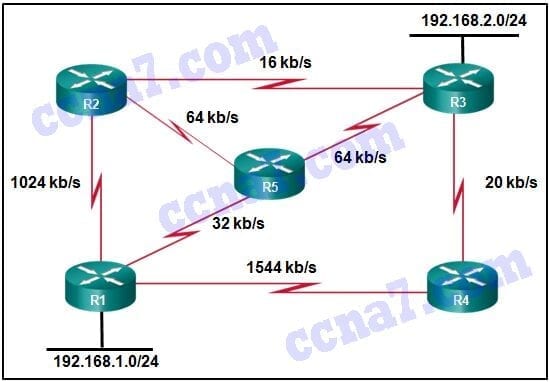
Cert Practice Exam ICND2 006
- R1, R4, R3
- R1, R5, R3
- R1, R2, R3
- R1, R2, R5, R3
-
Refer to the exhibit. A network administrator is configuring EIGRP AS 20 on Router_2 and has received the error that is shown. What is the cause of the error?

Cert Practice Exam ICND2 008
- The autonomous system (AS) number is not the same as the number on other routers in this network.
- The IPv6 routing process cannot be implemented until IPv6 routing is enabled.
- The EIGRPv6 interface configuration is incomplete.
- The passive-interface default command has been implemented for EIGRPv6.
-
When a link failure occurs on a network running EIGRP, how does DUAL determine a replacement route to a destination router?
- DUAL examines the neighbor table to find the closest adjacency.
- DUAL examines the routing table to find a feasible successor route.
- DUAL examines the topology table to find a feasible successor route.
- DUAL immediately sends queries to neighboring routers to build a new routing table.
-
Refer to the exhibit. Router R2 has recently been configured and connected via interface Gigabit Ethernet 0/0 to router R1. R1 is configured correctly, but fails to establish a neighbor relationship with R2. What is the problem?
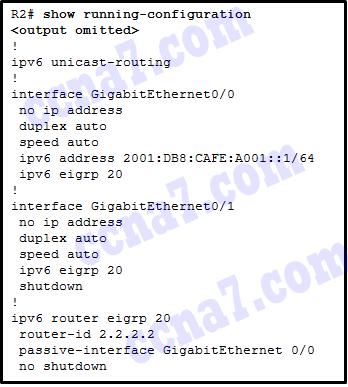
Cert Practice Exam ICND2 010
- The command ipv6 unicast-routing should be implemented in the router configuration mode.
- The command ipv6 unicast-routing has not been implemented.
- The EIGRPv6 process has not been activated on interface Gigabit Ethernet 0/0.
- The passive-interface command is preventing hello packets from being sent.
-
Which two aspects of the configuration of EIGRP for IPv6 differ from its configuration for IPv4? (Choose two.)
- For IPv6 no router ID is required for the EIGRP routing process to start.
- No network command is needed to enable EIGRP for IPv6.
- IPv6 requires a global unicast address on EIGRP interfaces.
- For IPv6, the autonomous system values on routers in a domain running EIGRP do not have to match.
- EIGRP on IPv6 is configured directly on router interfaces.
-
Which EIGRP route would have the preferred administrative distance?
- a summary route
- an internal route
- an external route that is redistributed from RIP
- an external route that is redistributed from OSPF
-
Refer to the exhibit. Which two networks contain feasible successors? (Choose two.)

Cert Practice Exam ICND2 017
- 192.168.71.0
- 192.168.51.0
- 10.44.100.252
- 10.44.104.253
- 10.44.101.252
-
Which three metric weights are set to zero by default when costs in EIGRP are being calculated? (Choose three.)
- k1
- k2
- k3
- k4
- k5
- k6
-
Refer to the exhibit. A network engineer is troubleshooting host connectivity on a LAN that uses a first hop redundancy protocol. Which IPv4 gateway address should be configured on the host?
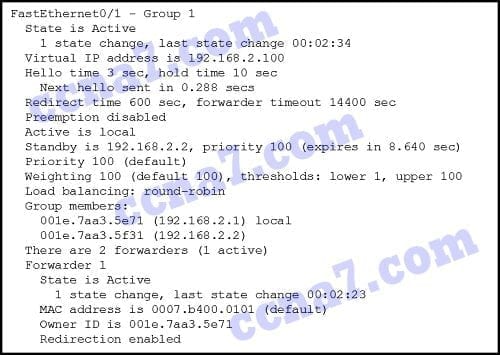
Cert Practice Exam ICND2 002
- 192.168.2.0
- 192.168.2.1
- 192.168.2.2
- 192.168.2.100
-
Refer to the exhibit. What protocol can be configured on gateway routers R1 and R2 that will allow traffic from the internal LAN to be load balanced across the two gateways to the Internet?
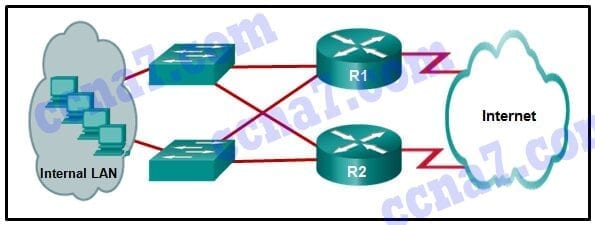
Cert Practice Exam ICND2 003
- STP
- PVST
- PVST+
- GLBP
-
Refer to the exhibit. An administrator is examining the message in a syslog server. What can be determined from the message?
- This is a notification message for a normal but significant condition.
- This is an alert message for which immediate action is needed.
- This is an error message for which warning conditions exist.
- This is an error message indicating the system is unusable.
-
What are two characteristics of SNMP community strings? (Choose two.)
- A vulnerability of SNMPv1, SNMPv2, and SNMPv3 is that they send the community strings in plaintext.
- Commonly known community strings should be used when configuring secure SNMP.
- If the manager sends one of the correct read-only community strings, it can get information and set information in an agent.
- SNMP read-only community strings can be used to get information from an SNMP-enabled device.
- SNMP read-write community strings can be used to set information on an SNMP-enabled device.
-
Which management protocol can be used securely with Cisco devices to retrieve or write to variables in a MIB?
- SNMP version 1
- SNMP version 2
- SNMP version 2c
- SNMP version 3
-
What is an SNMP management agent?
- a computer loaded with management software and used by an administrator to monitor a network
- a database that a device keeps about network performance
- software that is installed on devices managed by SNMP
- a communication protocol that is used by SNMP
-
What are three parameters that are used by NetFlow to classify traffic? (Choose three.)
- ingress interface
- TOS field
- egress interface
- number of packets
- number of bytes
- port number
-
Refer to the exhibit. R1 and R2 are connected to the same LAN segment and are configured to run OSPFv3. They are not forming a neighbor adjacency. What is the cause of the problem?
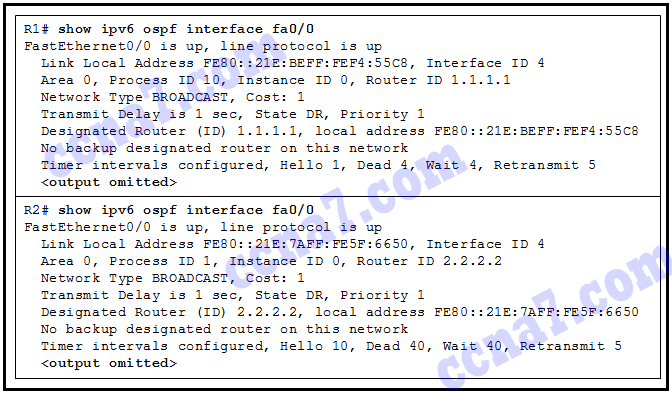
Cert Practice Exam ICND2 001
- The IPv6 addresses of R1 and R2 are not in the same subnet.
- The OSPFv3 process IDs of R1 and R2 are different.
- The timer intervals of R1 and R2 do not match.
- The priority value of both R1 and R2 is 1.
-
Refer to the exhibit. A network technician has added router R0 to an existing network that contains router R1. R0 is configured with EIGRP and is connected to R1 via the Fa0/0 interface of each router. After completing an analysis of the network, the technician notices that the routes to the networks that are supported by routers R0 and R1 are not being exchanged. What is a possible cause for this failure?
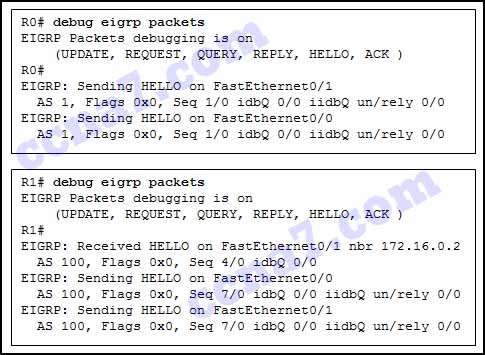
Cert Practice Exam ICND2 014
- R0 was configured with the wrong autonomous system number.
- FastEthernet interfaces on R0 are in a shutdown state.
- Interface Fa0/0 on R0 is configured as a passive interface.
- Interface Fa0/0 on R1 is configured as a passive interface.
-
Refer to the exhibit. Router R1 has recently been configured to operate in an IPv6 only network and is connected via interface Gigabit Ethernet 0/0 to router R2. R2 is configured correctly, but will not form a neighbor relationship with R1 What is the problem?
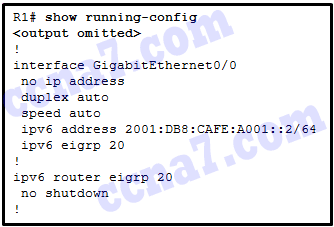
Cert Practice Exam ICND2 009
- The IP address is missing on interface Gigabit Ethernet 0/0.
- The command ipv6 unicast-routing has not been implemented.
- The router ID has not been created on router R1.
- The EIGRPv6 process has not been activated on interface Gigabit Ethernet 0/0.
-
A network administrator is troubleshooting router RA in an EIGRP autonomous system. The administrator needs to obtain the IP addresses of the other routers with which router RA has established adjacencies. It is also important to obtain information of the queue counts on the neighbor routers. What command will do this?
- show ip eigrp interfaces
- show ip eigrp neighbors
- show cdp neighbor details
- show ip eigrp topology all-links
-
What is the most likely cause when the output of the show interface command shows that a switch interface is up but the line protocol is down?
- A cable is not attached to the interface.
- An incorrect default gateway has been configured.
- An encapsulation type mismatch exists.
- An incorrect cable type has been attached to the interface.
-
Refer to the exhibit. Inter-VLAN communication between VLAN 10, VLAN 20, and VLAN 30 is not successful. What is the problem?
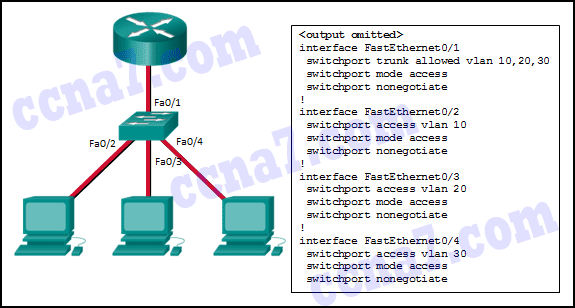
Cert Practice Exam ICND2 018
- The access interfaces do not have IP addresses and each should be configured with an IP address.
- The switch interface FastEthernet0/1 is configured as an access interface and should be configured as a trunk interface.
- The switch interface FastEthernet0/1 is configured to not negotiate and should be configured to negotiate.
- The switch interfaces FastEthernet0/2, FastEthernet0/3, and FastEthernet0/4 are configured to not negotiate and should be configured to negotiate.
-
Refer to the exhibit. While planning an upgrade, a network administrator uses the Cisco NetFlow utility to analyze data flow in the current network. What generated the most packets?
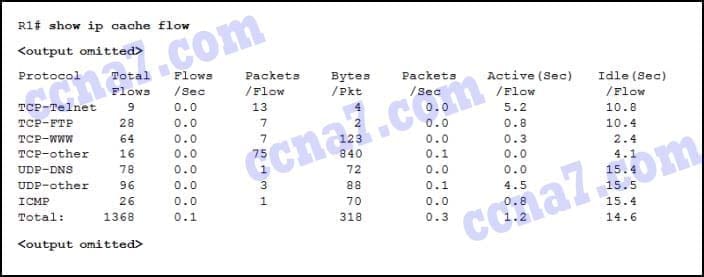
Cert Practice Exam ICND2 016
- ICMP
- TCP-Telnet
- TCP-other
- UDP-DNS
- UDP-other
-
What two encryption algorithms are used in IPsec VPNs? (Choose two.)
- DH
- PSK
- IKE
- AES
- 3DES
-
Which three statements describe the building blocks that make up the IPsec protocol framework? (Choose three.)
- IPsec uses encryption algorithms and keys to provide secure transfer of data.
- IPsec uses Diffie-Hellman algorithms to encrypt data that is transferred through the VPN.
- IPsec uses 3DES algorithms to provide the highest level of security for data that is transferred through a VPN.
- IPsec uses secret key cryptography to encrypt messages that are sent through a VPN.
- IPsec uses Diffie-Hellman as a hash algorithm to ensure integrity of data that is transmitted through a VPN.
- IPsec uses ESP to provide confidential transfer of data by encrypting IP packets.
-
Which WAN technology can serve as the underlying network to carry multiple types of network traffic such as IP, ATM, Ethernet, and DSL?
- ISDN
- MPLS
- Frame Relay
- Ethernet WAN
-
Which WAN connectivity method would be used in a remote location where there are no service provider networks?
- cable
- VPN
- VSAT
- WiMAX
-
Which statement describes cable?
- Delivering services over a cable network requires downstream frequencies in the 50 to 860 MHz range, and upstream frequencies in the 5 to 42 MHz range.
- The cable subscriber must purchase a cable modem termination system (CMTS).
- Each cable subscriber has dedicated upstream and downstream bandwidth.
- Cable subscribers may expect up to 27 Mbps of bandwidth on the upload path.
-
The output of the show ip interface brief command indicates that Serial0 is up but the line protocol is down. What are two possible causes for the line protocol being in the down state? (Choose two.)
- The clock rate is not set on the DTE.
- An incorrect default gateway is set on the router.
- A network is missing from the routing protocol configuration.
- The encapsulation on the Serial0 interface is incorrect.
- Keepalives are not being sent by the remote device.
-
What are two WAN connection enhancements that are achieved by implementing PPPoE? (Choose two.)
- Encapsulating Ethernet frames within PPP frames is an efficient use of bandwidth.
- DSL CHAP features are included in PPPoE.
- PPP enables the ISP to assign an IP address to the customer WAN interface.
- An Ethernet link supports a number of data link protocols.
- CHAP enables customer authentication and accounting.
-
An administrator issued the following commands on router R1:
R1(config)# logging 192.168.10.2
R1(config)# logging trap 5What conclusion can be drawn from this configuration?
- The only messages that appear on the syslog server are those with severity level of 4 or lower.
- Messages with severity level of 6 or higher appear only on the router console output.
- The only messages that appear on the syslog server are those with severity level of 5.
- Messages with severity level of 5 or lower appear on the router console output and are sent to the syslog server.
-
Fill in the blank.
A spanning-tree network that has all of the switched ports in either a blocking or forwarding state is considered a converged network.
-
Fill in the blank. Use only an acronym.
PPPoE creates a PPP tunnel through the DSL connection for the purpose of sending PPP frames.
-
Match the port state with its condition. (Not all options are used.)
- Question

Cert Practice Exam ICND2 Question 001
- Answer
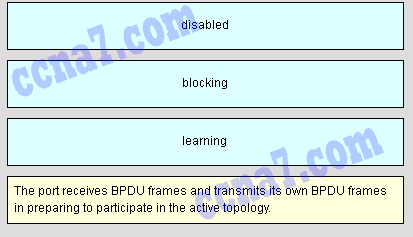
Cert Practice Exam ICND2 Answer 001
- Question
-
Match the FHRP protocols to their description. (Not all options are used.)
- Question

Cert Practice Exam ICND2 Question 003
- Answer
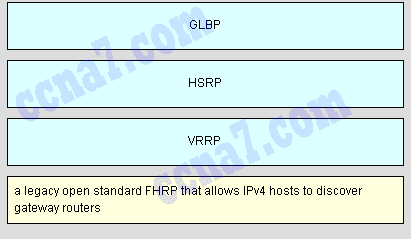
Cert Practice Exam ICND2 Answer 003
- Question
-
Match each description to its corresponding LSA type. (Not all options are used.)
- Question

Cert Practice Exam ICND2 Question 002
- Answer

Cert Practice Exam ICND2 Answer 002
- Question
-
Open the PT Activity. Perform the tasks in the activity instructions and then answer the question.
Which task has to be performed on Router 1 for it to establish an OSPF adjacency with Router 2?
- Issue the clear ip ospf process command.
- Remove the passive interface command from interface FastEthernet 0/0.
- Add the network 10.0.1.0 0.0.0.255 area 0 command to the OSPF process.
- Change the subnet mask of interface FastEthernet 0/0 to 255.255.255.0.
-
Open the PT Activity. Perform the tasks in the activity instructions and then answer the question.
Why are users in the OSPF network not able to access the Internet?
- The default route is not redistributed correctly from router R1 by OSPF.
- The interface that is connected to the ISP router is down.
- The OSPF network statements are misconfigured on routers R2 and R3.
- The OSPF timers that are configured on routers R1, R2, and R3 are not compatible.
- The network statement is misconfigured on router R1.